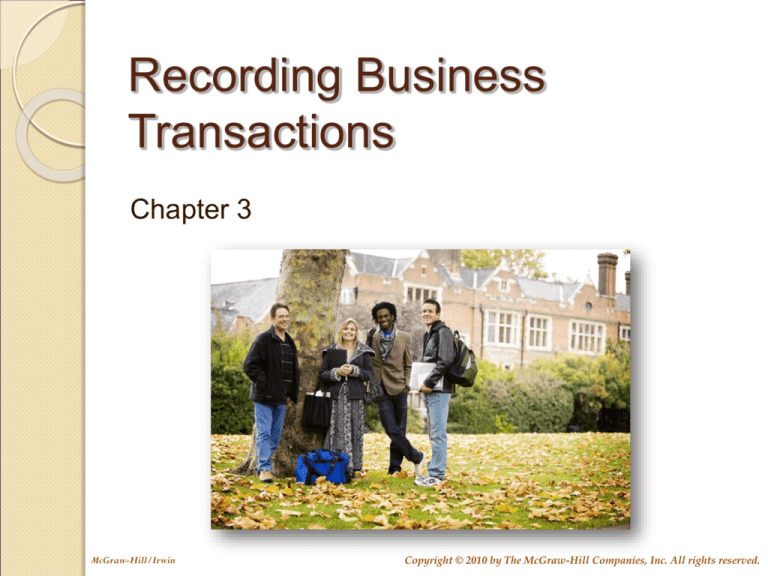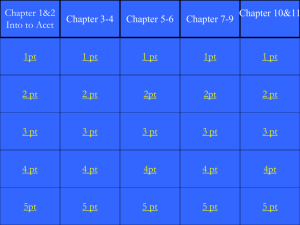
Recording Business
Transactions
Chapter 3
McGraw-Hill/Irwin
Copyright © 2010 by The McGraw-Hill Companies, Inc. All rights reserved.
The Role of Accounting Records
Establishes accountability for assets
and transactions.
Keeps track of routine business
activities.
Obtains detailed information about a
particular transaction.
Evaluates efficiency and
performance within company.
Maintains evidence of a company’s
business activities.
3-2
1) THE LEDGER
Cash
Accounts
Payable
Share
Capital
Accounts are
individual records
showing increases
and decreases.
The entire group of
accounts is kept
together in an
accounting record
called a ledger.
3-3
The Use of Accounts
Increases are
recorded on one side
of the T account, and
decreases are
recorded on the
other side.
Title of Account
Left
or
Debit
Side
Right
or
Credit
Side
3-4
The T-Account
Account Title
Debit
Credit
LEFT SIDE
3-5
The T-Account
Account Title
Debit
Credit
RIGHT SIDE
3-6
Debit and Credit Entries
Receipts are
on the debit
side.
5/1
5/25
5/29
5/31
Bal.
Cash
8,000
5/2 2,500 Payments are
credit
75
5/8 2,000 on the
side.
750 5/28
150
5/31
50
4,125
The balance is the
difference between the
debit and credit entries
in the account.
3-7
Debit and Credit Entries
Debits and credits affect accounts as follows:
A = L + E
ASSETS
LIABILITIES
EQUITIES
Debit
Credit
for
for
Increase Decrease
Debit
Credit
for
for
Decrease Increase
Debit
Credit
for
for
Decrease Increase
3-8
Double Entry AccountingThe Equality of
Debits and Credits
A = L + E
=
Debit
balances
Credit
balances
In the double-entry accounting system,
every transaction is recorded by equal
dollar amounts of debits and credits.
3-9
Let’s record
selected
transactions
for JJ’s Lawn
Care Service in
the accounts.
3-10
1 May: Jill Jones and her family invested $8,000
in JJ’s Lawn Care Service and received 800 shares
of stock.
Will
Cash
Cash
increases
increase
$8,000
or decrease?
with a debit.
Cash
1/5 8,000
Will
Share
Share
Capital
Capital
increases
increase$8,000
or
with
decrease?
a credit.
Share Capital
1/5 8,000
3-11
2 May: JJ’s purchased a riding lawn mower
for $2,500 cash.
Will
Cash
Cash
decreases
increase
$2,500
or decrease?
with a credit.
Cash
1/5 8,000
2/5 2,500
Tools
Will
& Tools
Equipment
&
Equipment
increases increase
$2,500
or
with
decrease?
a debit.
Tools & Equipment
2/5 2,500
3-12
8 May: JJ’s purchased a $15,000 truck. JJ’s
paid $2,000 in cash and issued a note payable
for the remaining $13,000.
Truck
increases
Will
Truck
increase
$15,000
with a debit.
or decrease?
Truck
8/5 15,000
Cash decreases
Will Cash and
$2,000 with a credit.
Notes Payable
Notes Payable
increase or
increases $13,000
decrease?
with a credit.
Cash
1/5 8,000
2/5 2,500
8/5 2,000
Notes Payable
8/5 13,000
3-13
11 May: JJ’s purchased some repair parts
for $300 on account.
Tools
Will
& Tools
Equipment
&
Equipment
increases $300
increase
with
or decrease?
a debit.
Accounts
Will Accounts
Payable
increases
Payable increase
$300 with
or
decrease?
a credit.
Tools & Equipment
2/5 2.500
11/5
300
Accounts Payable
11/5
300
3-14
18 May: JJ’s sold half of the repair parts to
ABC Lawns for $150, a price equal to JJ’s cost.
ABC Lawns agrees to pay JJ’s within 30 days.
Tools
Will
& Tools
Equipment
&
decreases
Equipment$150
increase
with
or adecrease?
credit.
Tools & Equipment
2/5 2,500 18/5
150
11/5
300
Accounts
Will Accounts
Receivable
Receivable
increases $150
increase
with
or decrease?
a debit.
Accounts Receivable
18/5
150
3-15
2) THE JOURNAL
It is a list in chronological order of all the
transactions for a business.
1 Identify transaction from source
documents.
2 Specify accounts affected.
3 Apply debit/credit rules.
4 Record transaction with description.
3-16
The Journal
What does a journal entry include?
– date of the transaction
– title of the account debited
– title of the account credited
– amount of the debit and credit
– description of the transaction
– dollar signs are omitted
3-17
The Journal
In an actual accounting system,
transactions are initially recorded in the
journal.
GENERAL JOURNAL
Date
Account Titles and Explanation
Debit
Credit
2009
1
May Cash
Share Capital
8,000
8,000
Owners invest cash in the business.
3-18
Posting Journal Entries to the
Ledger Accounts
Posting simply
means updating the
ledger accounts for
the effects of the
transactions
recorded in the
journal.
3-19
Posting Journal Entries to the
Ledger Accounts
GENERAL JOURNAL
Date
Account Titles and Explanation
Debit
Credit
2009
1
May Cash
8,000
Share Capital
8,000
Owners General
invest cash in
the business.
Ledger
Date
2009
1 May
Cash
Debit
Credit
8,000
Balance
8,000
3-20
Posting Journal Entries to the
Ledger Accounts
GENERAL JOURNAL
Date
Account Titles and Explanation
Debit
Credit
2009
1
May Cash
8,000
Share Capital
8,000
Owners General
invest cash in
the business.
Ledger
Date
2009
1 May
Share Capital
Debit
Credit
8,000
Balance
8,000
3-21
Posting Journal Entries to the
Ledger Accounts
GENERAL JOURNAL
Date
Account Titles and Explanation
Debit
Credit
2009
2
May Tools & Equipment
Cash
2,500
2,500
Purchased lawn mower.
Let’s see what the cash account looks like
after posting the cash portion of this
transaction for JJ’s Lawn Care Service.
3-22
Ledger Accounts After Posting
Date
2009
1 May
2
General Ledger
Cash
Debit
Credit
8,000
2,500
Balance
8,000
5,500
This ledger format is referred to as a
running balance.
3-23
Ledger Accounts After Posting
Date
2009
1 May
2
General Ledger
Cash
Debit
Credit
8,000
2,500
Balance
8,000
5,500
T accounts are simplified versions of
the ledger account that only show the
debit and credit columns.
3-24
What is Profit (Net Income)?
Profit is not an asset; it is an increase in
equity from profitable operations of the
business.
A = L + E
Increase
Decrease
As income is earned,
either an asset is
increased or a liability is
decreased.
Increase
Profit always
results in the
increase of
Equity
3-25
Retained Earnings
A = L + E
Share
Capital
Retained
Earnings
The balance in the Retained Earnings account
represents the profit of the corporation over the
entire lifetime of the business, less all amounts
which have been distributed to the shareholders as
dividends.
3-26
The Income Statement: A Preview
JJ's Lawn Care Service
Income Statement
For the Month Ended 31 May 2009
Sales Revenue
Operating Expense:
Gasoline Expense
Profit
$
750
$
50
700
The income statement summarizes the
profitability of a business for a specified period
of time.
3-27
REVENUE and EXPENSES
The price for
goods sold
and services
rendered during a
given accounting
period.
Increases
equity.
The costs of
goods and
services used up
in the process of
earning revenue.
Decreases
equity.
3-28
The Realization Principle: When
To Record Revenue
Realization Principle
Revenue should be
recorded at the time
goods are sold and
services are
rendered.
3-29
The Matching Principle: When
To Record Expenses
Matching Principle
Expenses should be
recorded in the
period in which they
are used up.
3-30
Debit and Credit Rules for
Revenue and Expenses
Expenses
decrease
equity.
EQUITIES
Debit
Credit
for
for
Decrease Increase
Revenues
increase
equity.
EXPENSES
REVENUES
Debit
Credit
for
for
Increase Decrease
Debit
Credit
for
for
Decrease Increase
3-31
DIVIDENDS
•
A dividend is a distribution of assets (usually
cash) by a corporation to its stockholders.
•
SIMILAR TO expenses; BUT, not an expense
3-32
Dividends
Payments to
owners
decrease
equity.
EQUITIES
Debit
Credit
for
for
Decrease Increase
DIVIDENDS
Debit
Credit
for
for
Increase Decrease
Owners’
investments
increase
equity.
SHARE CAPITAL
Debit
Credit
for
for
Decrease Increase
3-33
Summary of Debit- Credit Rules for
Revenues, Expenses and Dividends
Owner’s Equity
Decreases recorded by debits
Expenses decrease O.E
Expenses are recorded by debits
Dividends reduce owners’ equity
Dividends are recorded by debits
Increaes recorded by credits
Revenue increases O.E
Revenue is recorded by credits
3-34
Let’s analyze the
revenue and
expense
transactions for
JJ’s Lawn Care
Service for the
month of May.
We will also
analyze a dividend
transaction.
3-35
29 May: JJ’s provided lawn care services for
a client and received $750 in cash.
Will
Cash
Cash
increases
increase
$750
or decrease?
with a debit.
Cash
1/5 8,000
2/5 2,500
29/5
750
8/5 2,000
Will
Sales
Sales
Revenue
Revenue
increases
increase
$750
or with
decrease?
a credit.
Sales Revenue
29/5
750
3-36
31 May: JJ’s purchased gasoline for the lawn
mower and the truck for $50 cash.
Cash
Will Cash
decreases
increase
$50
or
with
decrease?
a credit.
Cash
1/5 8,000
2/5 2,500
29/5
750
8/5 2,000
31/5
50
Gasoline
Will Gasoline
Expense
Expense
increasesincrease
$50 withor
a
decrease?
debit.
Gasoline Expense
31/5
50
3-37
31 May: JJ’s Lawn Care paid Jill Jones and
her family a $200 dividend.
Will
Cash
Cash
decreases
increase
$200
or decrease?
with a credit.
Cash
1/5 8,000
2/5 2,500
29/5
750
8/5 2,000
31/5
50
31/5
200
Will Dividends
Dividends increase
increase or
$200 with a debit.
decrease?
31/5
Dividends
200
3-38
3) TRIAL BALANCE
It is an internal document.
It is a listing of all the accounts with their
related balances.
Proof of the equality of debit and credit
balances.
3-39
Locating Trial Balance Errors
What if it doesn’t balance ?
Is the addition correct?
Are all accounts listed?
Are the balances listed correctly?
DEBITS
CREDITS
3-40
Now, let’s look at
the Trial Balance
for JJ’s Lawn
Care Service for
the month of May.
3-41
JJ's Lawn Care Service
Unadjusted Trial Balance
31 May 2009
Cash
$
3,925
Accounts receivable
75
Tools & equipment
2,650
Truck
15,000
Notes payable
$
Accounts payable
Share capital
Dividends
200
Sales revenue
Gasoline expense
50
Total
$
21,900 $
13,000
150
8,000
750
21,900
All balances are taken from the ledger accounts on 31
May after considering all of JJ’s transactions for the
month.
3-42
End of Chapter 3
3-43






